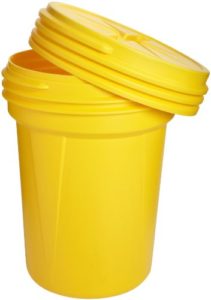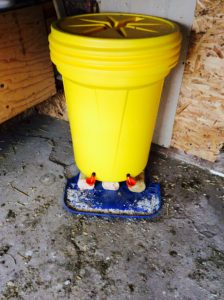After spending all last winter hauling drinking water out to the chickens, I knew I needed a better solution this year. I resolved to find a large volume option that would provide fresh water without the repeated struggle of lifting heavyweight. I wanted to design a poultry drinker appropriate for my space as well as the fluctuations in the North Dakota climate.
Not that I ever had amazing upper body strength, but over the years, age and a bad back didn’t do me any favors. Considering the average weight per 1-gallon of water is 8.34 pounds, my 3-gallon fountain was every bit of 25 pounds.
Although I know this isn’t considered extremely heavy for a 40-something woman to carry. Try doing it in full snow gear. Through howling bitter winds. Pelted by snow and ice. While trudging through heavy snow over your knees. Every day, of every week, for 4-5 months.
The answer seemed simple enough. Find a plastic drum large enough to hold up to 55 gallons of water. The key was to do it without breaking the bank.
Most drums I found were running around the $75 range, a little rich for my tastes. I didn’t have a supplier in my area offering used drums so I had to keep searching. I finally settled on a 30-gallon drum with a screw-on lid that would be delivered directly to my home. Thank you Amazon Prime!!

At around $38, it was a bargain in comparison to other drums I was finding. A positive feature of this drum was the twist-off cap easily allowing me to hook up watering cups and gain access for cleaning.
For the actual watering mechanism, I chose watering cups instead of nipples or a trough. The cups would be much less likely to drip water into the litter of the coop floor. Because they were smaller than trough style drinkers, they would also be less likely to collect foreign matter resulting in dirty water.

I went with Automatic Chicken Drinker Cups with the hardware included. Many sellers do not include the wing nut and gasket part of the assembly. The cups can easily be screwed into a 3/8-inch hole drilled into the side of a drum or bucket. I like the added hardware to ensure the drinker is held securely to the drum with a drip-free seal.

When positioning my cup holes in the side of the drum, I had to take into account the distance from the floor. During the winter I use the deep litter method to keep my coop clean. After raising my drum up on blocks to account for the litter, I could best determine the proper height for hole placement.
With that said, I wanted to place the holes as near to the bottom of the drum as possible. This would give me the most use of the entire volume of water. Also, as I’m using a submersible tank heater, I would like my drinkers as close to the heat source as possible. With any luck, this will reduce the chances of water freezing once outside the drum.

Once the cups were in place, I simply had to arrange the final product within my coop. Raised on blocks, angled away from the corner and preferably not directly under the roosting or nesting space. I did add an old storage tote top underneath the cup area to retain and control “from the beak” drips or possible leaks.
To test my watering set up I added water just above the level of the cups. By doing this, I could still move the drum around while testing for leaks. I added a couple of dried mealworm treats to the cups to spark my chicken’s interest. Crushed calcium grit was also sprinkled on the makeshift drip pan to boost the curiosity factor.

Once I was satisfied with the operation of all mechanisms the drum was filled with fresh water and the top loosely put into place. A loose top will allow water to gravity feed the drinker cups without a vacuum halting the flow.
As temperatures start to drop, the likelihood of water turning to ice increases. Thankfully, my coop was equipped with electricity making this part of my goal easy to obtain.

I purchased a high efficiency submersible 500-watt DE-ICER that is safe for use with plastic on Amazon. It has multiple thermostats to keep it from getting too warm and of all the options I looked at, it had the highest reviews.
The Amazon documentation page says that it is rated for heating up to 25 gallons but the box says 70 gallons. I believe this is determined by the wattage option purchased. Either way, I should be covered.
Overall, I feel very pleased with this setup. It was simple enough to not require the strength or mechanical skills of my husband, so, anyone could do it. The final costs topped out around $100, but this set up should last for years, through every season.
Down the road, I may introduce a spigot style shutoff valve attached directly to the drum. If placed in-line prior to each drinker cup it would be easier to cut the flow of water to replace any damaged parts.
In the future, I may also look to treat my chicken water if algae growth becomes apparent. For now, untreated well water is the drink of choice at this trendy bar!













4 Comments
Hi – I made one like this but recently the cups and levers have frozen (and it’s not that cold yet here). The water in the bucket is fine. My submersible heater is as close to the cups as it can be. Have you had this issue? Any ideas? I love my girls but HATE the winter watering!
I do have this issue when the temps fall below freezing inside the coop which is rare. I keep a heat gun handy to thaw out the cups first thing in the morning. During the day the girls drink enough that I rarely have to worry. I have considered added a plug in thermostat pipe tape style heat around the cups but have yet to do it.
I see this article is a couple of years old. (And prices have gone up on the items you mention!) I’m wondering how your waterer is holding up by now? And have you had to make any modifications or is it doing great “as is”? Did it ever freeze up on you? Please EMAIL ME so I’ll know you answered. Thank you.
AppyHorsey@windstream.net
I also am curious as to how the system has held up over time and any issues you might have had with it.
I have 80 chickens dispersed through 3 coops and a cattle shed (their idea to take up residence in the shed, not mine) and we literally have less than 2 months of the year without freezes and nighttime temps can easily hit 20 below 0 F so the frozen water is a serious issue for me.
My coops have south-facing clear roofing panels for the roofs so they heat up nicely during the day, but boy howdy let me tell you, it does freeze in there at night.